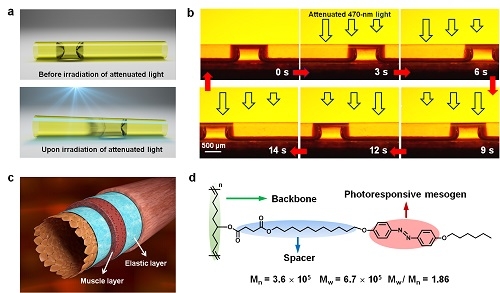Search
Title: Photocontrol of Fluid Slugs in Liquid Crystal Polymer Microactuators
Author: Jiu-an Lv, Yuyun Liu, Jia Wei, Erqiang Chen, Lang Qin, Yanlei Yu*
Journal: Nature, 2016, 537, 179-184
Abstract:
The manipulation of small amounts of liquids has applications ranging from biomedical devices to liquid transfer. Direct light-driven manipulation of liquids, especially when triggered by light-induced capillary forces, is of particular interest because light can provide contactless spatial and temporal control. However, existing light-driven technologies suffer from an inherent limitation in that liquid motion is strongly resisted by the effect of contact-line pinning. Here we report a strategy to manipulate fluid slugs by photo-induced asymmetric deformation of tubular microactuators, which induces capillary forces for liquid propulsion. Microactuators with various shapes (straight, ‘Y’-shaped, serpentine and helical) are fabricated from a mechanically robust linear liquid crystal polymer. These microactuators are able to exert photocontrol of a wide diversity of liquids over a long distance with controllable velocity and direction, and hence to mix multiphase liquids, to combine liquids and even to make liquids run uphill. We anticipate that this photodeformable microactuator will find use in micro-reactors, in laboratory-on-a-chip settings and in micro-optomechanical systems.
Fulltext Link:
JRCN_1_DD01_CN_NatureRJ_article_paid_XMOL

Manipulating small amounts of liquids to perform reactions, analysis is of great value in both scientific research and practical applications. Direct light-driven manipulation of liquids is of particular interest because light can provide contactless spatial and temporal control. Herein, we report robust tubular microactuators (TMAs) prepared from a newly designed linear liquid crystal polymer (LLCP). The liquid droplet is self-propelled towards the narrower end due to the increase of cross-sectional area upon irradiation by 470 nm light which generates adjustable capillary force; such irradiated TMAs can thus successfully manipulate liquid motion by light. In addition, microactuators with various shapes (straight, ‘Y’-shaped, serpentine and helical) present a conceptually novel way to propel liquids by capillary force arising from photo-induced asymmetric deformation. These microactuators are able to exert photocontrol of a wide diversity of liquids over a long distance with controllable velocity and direction, and hence to mix multiphase liquids and even to make liquids run uphill, which relies on neither wettability gradients nor the Marangoni effect. It is worth noting that the TMAs can propel not only simple liquids spanning a broad range of polarity, but also complex fluids widely used in biomedical and chemical engineering, they thus have considerable potential application as micro-pumps in microsystems technology and architecture without any aid from additional components.







